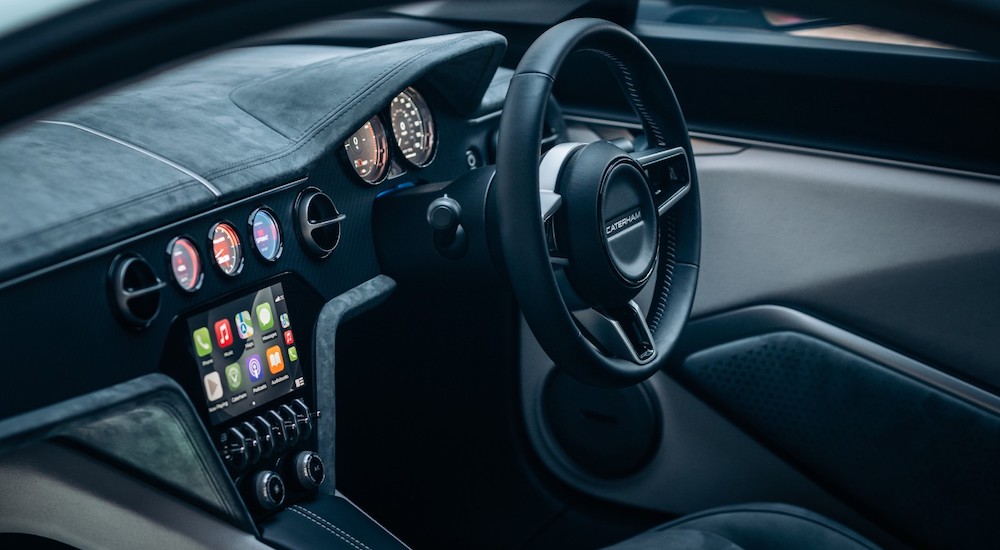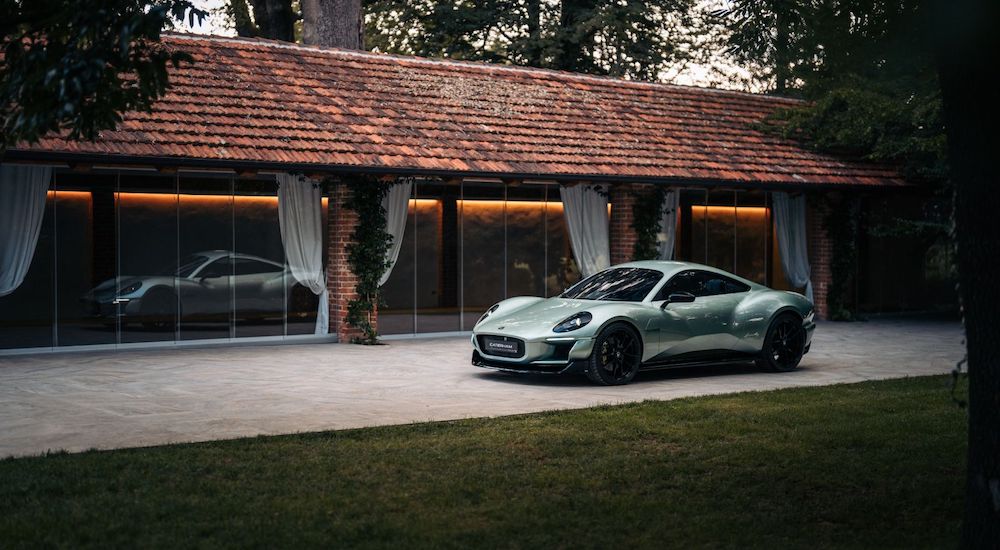How many model names can you recall which originated before 1960 and are still in use today? I can think of nine (read to the end for my answers), and only one of them has been a marque’s sole offering for the duration. The Caterham Seven is a direct evolution of the original Lotus Seven of 1957, and remains the only Caterham production car to this day–but not for long. At this summer’s Goodwood Festival of Speed, a partner to the Seven was announced, something to prop the company’s image up from kit car designer to bona fide sports car boutique. They call it the Caterham Project V.
A Simple, Lightweight Legacy
Caterham Cars was founded in 1959, and quickly established itself as a major distributor of the Lotus Seven, which was an instant hit for Colin Chapman’s young business. The iconic sports car has always been basic, inexpensive and lightweight, the embodiment of the classic Lotus mantra to “simplify, then add lightness.” It still underwent four revisions before being terminated in 1973. Caterham bought the rights to continue production from Colin Chapman, and the rest is history. More than 70 unique versions of the Seven have been built since, with no definitive generational overhauls to speak of, and nothing, save the very short-lived 21, to share the load of supporting Caterham in the 50 years since.
In maintaining the Seven this way, Caterham has managed to stay true to that quintessential Chapman philosophy, while the original Lotus brand arguably abandoned the concept of simplicity a great many years ago. But Caterham has also remained a lower tier of automaker, viewed as more of a hobby shop than as a serious sports car brand. Much in the same way as Lotus seeks to become a global brand with their upcoming turn towards electric passenger vehicles, Caterham is seeking to enter the electric age as a brand worthy of consideration for daily drivers. To do this, they invited six designers to submit concepts for the very first homegrown Caterham product, and thus selected Anthony Jannarelly to be their first head of design.
Timeless Vintage
Jannarelly made a name for himself with his eponymous Jannarelly Design-1, a modern roadster with obvious retro influences such as the Shelby Cobra. It was a similar train of thought that produced the concept art that got him a new job, a vision that has now been manifested (courtesy of Italdesign) in the all-electric Project V. We can expect the production version to appear essentially identical to this “concept.” As CEO Bob Laishley pointed out, Caterham isn’t in a position to spend millions on infeasible show cars. Project V has been fleshed out as a serious proof of concept, and for his part, Jannarelly is standing guard to ensure his vision reaches the road. “I’m like a custodian of the shape,” he’s quoted as saying. “I need to make sure this shape will go into production.”
Designing the Project V did not start with a silhouette, however. Jannarelly started by addressing the vehicle’s defining characteristic with a technique for ensuring the car could avoid the “lifted sedan” look of so many EVs today, an entirely blacked-out layer of functional aero features whose color provides a slimming effect to mask the presence of electric powertrain components below the cabin. Then he produced a middle “layer” of sharp geometric features, reflecting modernity and the Seven’s no-frills aluminum panels, before capping the project with a wonderfully “organic and soft” vintage sports car shape.
“Imagine asking a kid to draw a sports car. You have the two wheels, then a nice curve [over] each wheel that requires a wheel arch, and then a nice curve over the passenger and driver,” he explained to Petrol Ped when describing the philosophy behind the design. Hints of inspiration are everywhere, from the Seven-style “grille,” to the door aperture which is directly sourced from the Audi TT, to the 1960s Lotus Elan-style tail lights.
The vintage aesthetic continues on the inside, where the surprisingly spacious cabin is adorned with a clean, flat carbon fiber dashboard. Caterham Seven aesthetics are preserved by presenting individual circular tachometer and speedometer gauges behind the wheel, except these gauges are digital. Round vents, satisfying metal toggle switches, and a basic infotainment system (with no proprietary OS except to enable Apple CarPlay phone mirroring, because why waste time and money developing their own inferior system) results in a space that adheres to Caterham minimalism without becoming impractical.
Turn around in the thin, Maserati-sourced seat and observe a surprising win-win compromise, even for an EV: a single-seat rear passenger compartment. As with many modern EVs, the cabin is much larger relative to the size of the vehicle compared to an ICE sports car that has to fit a combustion engine somewhere. What would be unthinkable in a similarly-sized ICE sports car becomes readily achieved in the Project V, making it significantly more practical than competitive two-seaters. Yet by offering just a single centrally-located rear seat as the base configuration, the car is lighter than a 2+2, and any occupant of said rear seat gets more space than they would if they were stuffed behind the driver.
An EV That Can Handle?
Speaking of weight, let’s get to the technical details. The three-seat configuration allows Caterham to project a curb weight of only 1190 kg (that’s 2623 lbs to us revolutionary scoundrels), which would put it in the same weight class as a Fiat 500e. It’ll even undercut the Subaru BRZ by 200 lbs.
However, it takes more than a seat delete and a small footprint to get an EV down below the 3000 lb threshold. Start with a carbon fiber and aluminum chassis for one, and then execute the masterful stroke of omitting a “frunk.” Though the car sacrifices some of its potential to be a practical daily driver as a result, both Laishley and Jannarelly spoke to the decision to seal up the hood as a triple victory.
- Apertures are complex and require costly time to design and refine. Sealing off this part of the vehicle significantly reduces development requirements.
- The tubs, seals, latches, hinges, and more which would be necessitated by having a frunk can all be omitted, saving significant weight.
- The engineering team can have free reign to design the suspension exactly the way they want for optimal performance, including strategically positioning the steering rack in front of the wishbone suspension, a dynamically superior configuration made nearly impossible with a frunk tub in the way.
Last, but not least, an EV can only be as light as the battery allows. Many EVs feature lithium ion battery packs weighing 1,000 lbs or more, especially for trucks like the Rivian R1 and Hummer EV platforms. Caterham, however, is not generally concerned with range (the Seven can make roughly 160 miles on a full tank of gas) and is working with an exceptionally lightweight platform. As such, they’re leaning on current state-of-the-art technology to enable an 80 mm thick battery pack with a 55 kWh capacity. That’s peanuts for a grand tourer, but this is not a grand tourer, and the anticipated 249 mile range will be more than satisfactory to deliver the Caterham experience and a daily commuter.
Speaking of the battery, because it’s so small, Jannarelly was able to stuff it where he wanted to, specifically anywhere other than directly beneath the occupants as in many EVs. With segments under the driver’s feet and straddling the rear passenger, there’s nothing preventing him from placing the seats as low to the ground as possible, mitigating a common issue with modern EVs. They simply can’t replicate the low driving position of proper performance cars.
The Model S Plaid Is Not a Sports Car
At the same time that our collective jaws dropped at the Model S Plaid’s sub-2.0 second 0-60 time, enthusiasts quickly realized that the hypercar acceleration of souped-up EVs was unaccompanied by handling to match. The sheer mass of the cars necessitates luxury barge suspension, and there’s no escaping inertia. Perhaps hypercars like the Nevera and Evija can handle properly, but there’s one zero too many on their prices, and one or two too few on their production numbers to matter for the masses. One of the greatest questions on enthusiast’s minds for the last few years has been, “Will we ever get a proper sports car in the age of EV?”
I agree with EVO Magazine’s assessment that Caterham is on the verge of answering that question in the affirmative. Well under 3000 lbs, with a projected 0-60 time under 4.5 seconds, and a starting price right around $100,000 (all numbers subject to change, of course), there’s no reason to think Project V won’t perform even better than the well-reviewed GR86 platform. We’re talking about the company that’s been building the OG Lotus for 50 years after all.
Completely contradictory to the Seven’s boxy cigar shape, Project V flows seamlessly in all directions, simultaneously breathtaking and understated, with the potential to become an icon and a benchmark in its own right if its ambitions are realized. The transition to EVs will continue to be a painful one, fraught with DLC features, driving assist bugs, and infrastructure anxiety and resource scarcity. But if the Caterham Project V is able to deliver on its greatly feasible promise to be an electric sports car, maybe, just maybe, some of us will be able to “blat” that pain away.






